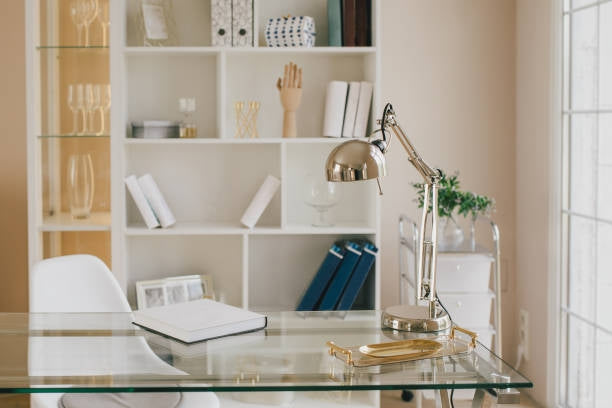Home Lighting Ideas

Lighting is more than just a practical necessity; it's an art that can transform your home. In this post, we're excited to guide you through the world of home lighting and give you specific tips on light layering. Creating a cozy atmosphere goes beyond just furniture, mattresses, and décor – that's why we're here to explore three essential lighting elements that will help you achieve a beautifully balanced home.

Ambient Lighting
Ambient lighting forms the base of your home's lighting design. Think of it as the starting point upon which the rest of your lighting plan is built. This layer ensures that every corner is well-lit, giving your rooms a warm and balanced feel. Ambient lighting is usually the first layer of lighting considered in a lighting design scheme.
Here's how you can achieve a well-layered ambient lighting design:
Plan for Even Coverage
Start by identifying the areas in each room that need consistent light. Consider the room's size, layout, and function to determine the number and placement of ambient lighting sources.
Ceiling Fixtures
Chandeliers, pendant lights, flush-mount fixtures, or even ceiling fans with integrated lighting can serve as ambient lighting sources.
Natural Light
Maximize the use of natural light through windows, glass doors, and skylights. Arrange furniture and decor to allow the daylight to reach as many areas as possible.
Wall Sconces
These fixtures can provide a warm and indirect glow that complements the main ceiling fixtures. Install them at mid-height along walls to distribute light evenly and minimize harsh
Balance Brightness
Ensure a consistent level of brightness throughout the room. Avoid bright or dim areas by distributing fixtures and using lighting controls like dimmer switches.
Lighting Zones
Divide your space into different lighting zones based on the activities that take place there. Each zone can have its own ambient lighting setup, allowing you to control each area.
Task Lighting
Task lighting is designed to provide focused illumination for specific activities or tasks. Unlike general ambient lighting, task lighting is directed to a particular area where a specific task is being performed. The goal of task lighting is to ensure that the task is carried out with enough brightness.
Creating a layered lighting look with task lighting involves combining different lighting sources to provide functional and aesthetic light. Here's how you can achieve this effect:
Identify Task Areas
Determine the areas in your home where specific tasks are performed. These could include reading corners, kitchen counters, desks, vanity areas, or workbenches.
Choose Task Lighting Fixtures
Select appropriate task lighting fixtures for each task area. For reading, consider adjustable desk lamps or floor lamps. For kitchens, under-cabinet lighting works well, while vanity lights suit grooming tasks.
Positioning
Place task lighting fixtures in a way that the light is directed where it's needed without causing glare or shadows. For reading, position the light source behind or beside you, aimed at your reading material. In kitchens, make sure under-cabinet lights illuminate the whole countertop.
Layer with Ambient Lighting
Combine your task lighting with ambient lighting to create a balanced effect. Ambient lighting provides general illumination, while task lighting offers focused brightness. Adjust the intensity of task lighting to complement the ambient lighting.
Flexible Lighting
Opt for task lighting with adjustable features. This allows you to direct the light where you need it for specific tasks.
Consistency
Maintain a consistent colour among your lighting to avoid a mismatched appearance.
Accent Lighting
Accent lighting is a lighting approach that aims to highlight specific aspects within a room. By directing light onto objects, architectural details, or areas, it adds visual interest and depth to the environment.
Layered accent lighting uses different lighting fixtures and techniques to highlight specific areas. Here's how you can achieve the look:
Identify Focal Points
Determine what you want to highlight in each room. It could be a piece of artwork, a unique architectural feature, or even a collection of decorative items.
Choose Lighting Fixtures
Select the appropriate lighting fixtures for each focal point. Picture lights are great for illuminating artwork, while track lighting offers flexibility for many points of interest. Under-cabinet lights work well for kitchens or display shelves. Wall-mounted sconces can highlight architectural elements.
Adjust Intensity
Consider the brightness of the accent lighting. You want it to be brighter than the ambient lighting but not overpowering. You can achieve this by using lower wattage bulbs or incorporating dimmer switches to control the intensity.
Create Contrast
Play with light and shadow by using uplighting and downlighting techniques. Uplights cast light onto walls or objects from below, while downlights illuminate from above.
Highlight Textures
Use accent lighting to bring out brick walls, textured wallpaper, or stone features. This technique adds dimension and visual interest.
Outdoor Accent Lighting
Extend accent lighting to the exterior of your home. Illuminate architectural elements, trees, or landscaping features to create an inviting ambiance in your outdoor spaces.
In wrapping up, layered lighting is all about finding the right balance. By combining ambient, task, and accent lighting you can transform your home into a space where every moment feels just right.



